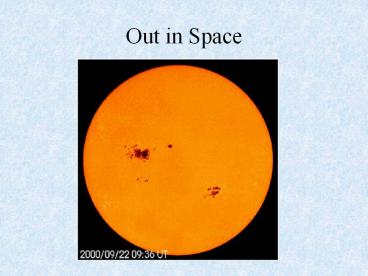Out in Space - PowerPoint PPT Presentation
1 / 14
Title:
Out in Space
Description:
Title: SUN SPOTS Author: Benton Last modified by: hbenton1 Created Date: 11/13/2006 1:42:11 AM Document presentation format: On-screen Show (4:3) Other titles – PowerPoint PPT presentation
Number of Views:87
Avg rating:3.0/5.0
Title: Out in Space
1
Out in Space
2
(No Transcript)
3
What keeps the planet and other object in
orbit around the sun? How are they
different? How are they alike? Which planet
has the most moons? Why?
Gravity and inertia
Inner- rocky Outer- gas
All have mass, orbit the sun
Jupiter,
as it has the largest mass.
4
What are some other things in our solar system
besides the sun and the planets?
5
Asteroid- a body composed of rock and/or
metal which orbits the Sun. Inner and outer
planets are separated by an asteroid belt. It
is larger than a meteoroid.
6
These fragments were left over from the
formation our Solar System about 4.6 billion
years ago.
(Certain rocks and meteorites have potassium and
uranium in them. These isotopes can decay. We
measure the amount of decay to determine how
long ago they formed.)
7
Our universe is about 13.6 billion years old. How
do we know how old the universe is?
By measuring the rates of expansion away from us
of distant galaxies
8
It is believed that a asteroid hit our planet
millions of years ago and caused the extinction
of the dinosaurs.
9
Meteoroid, Meteor, Meteorite
- What is the difference?
10
Meteoroid
A chunk of rock that is smaller than an asteroid
in space.
11
Meteor -
Chunk of rock/dust (meteoroid) traveling through
our atmosphere.
These are mistaken for falling stars.
12
A meteor is a bright streak of light that appears
briefly in the sky. Air friction heats the
meteoroid so that it glows. They usually burn up
when entering the atmosphere due to air friction.
13
Meteorite
A meteoroid that has hit the Earths surface.
14
A comet is huge frozen ball of ice mixed with
dust and rock. Most of the comets that can be
seen from Earth travel around the sun in long,
oval orbits. Astronomers believe that comets are
leftover debris from a collection of gas, ice,
rocks, and dust.
COMET
10 minutes































